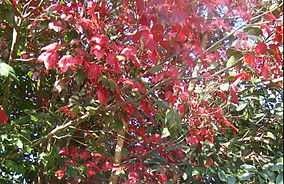Phu Luang Wildlife Sanctuary
| Phu Luang Wildlife Sanctuary | |
|---|---|
|
IUCN category IV (habitat/species management area) | |
|
Acer calcaratum leaves seasonally turning red | |
 Location in Thailand | |
| Location | Thailand |
| Nearest city | Loei |
| Coordinates | 17°7′16″N 101°32′48″E / 17.12111°N 101.54667°ECoordinates: 17°7′16″N 101°32′48″E / 17.12111°N 101.54667°E |
| Area | 896.95 km² |
| Established | December 18, 1974 |
| Governing body | Wildlife Conservation Division |
Phu Luang (Thai: ภูหลวง) Wildlife Sanctuary is a wildlife sanctuary in northern Thailand, located in the Phu Luang mountain area, in the south of Loei Province.[1] The area around the mountain is part of the Luang Prabang montane rain forests ecoregion.[2]
It covers an area of 897 km², covering area of the tambon Pla Ba and Tha Sala of Phu Ruea district, Phon Sung, Wang Yao and I Pum of Dan Sai, Nong Ngio and Saikhao of Wang Saphung, and Phu Ho of Phu Luang district.
History
The wildlife reserve was established in 1974. In 1985 it was further enlarged by 97 km². The reserve is named after its highest mountain, which peaks at 1571 m. The reserve covers the whole mountain plateau around the peak, which has an altitude of around 1200 m above sealevel. To west of the reserve the Loei River originates. Phu Luang means a large mountain or the Mountain of the King, formed by an uplift of the earth’s crust and a slide of soft soil down to the lower land.
Environment
There are overall 3 types of climate on Phu Luang, similar to a plain, with different temperatures. Summer starts from February to April with an average temperature of 20-24 °C. During this season, there are colourful blossoms such as dendrobiums, white wild orchids, white and red rhododendrons. The rainy season is from May to October, when the temperature is equally or slightly higher than in the summer. There will be tiny wild flowers in purplish pink scattered in the savanna. On the other hand, the temperature highly drops during the winter to 0-16 °C in November – January. On some days, the temperature can decrease to -4°C. During this season, Kuam Daeng (Acer calcaratum) will transform into red and shed their leaves. Kradum Ngoen (Eriocaulon henryanum Ruhle) and lady’s slipper orchids (Paphiopedilum sukhakulii Schoser & Senghas) comprise the undergrowth of the hill evergreen forest. On the east of Phu Luang, dinosaur’s footprints on the rock, aged more than 120 million years were discovered.
There are various kinds of forests such as mixed deciduous forest, dry evergreen forest, and hill evergreen forest. The most distinguished ones on Phu Luang are Pinus merkusii and Khasi Pine forests, savanna on plains, mounds, and stone terraces. Moreover, the wildlife sanctuary has organised the Phu Luang Nature Study Route, starting from Amphoe Phu Ruea at Khok Nok Kraba, passing Lan Suriyan, Pha Somdet, and the dinosaur’s footprints.
The reserve is home of an estimated 100 of wild Asian elephants. The Elephants Rehabilitation Project within the wildlife reserve is under the patronage of Queen Sirikit.[3]
The Phu Luang Cliff frog (Huia aureola) was found within the reserve in 2006, notable due to its ability to change its color. Also more than 160 species of orchids grow in the area.
Sources
- ↑ Phu Luang Wildlife Sanctuary - Protected Planet
- ↑ Luang Prabang montane rain forests
- ↑ Elephant and Men in Phu Luang, Chaipattana Journal, August 2001.
External links
- Royal Gazette entries for Phu Luang:
- "Luang Prabang montane rain forests)". Terrestrial Ecoregions. World Wildlife Fund.
- Forestry department (Thai only)
